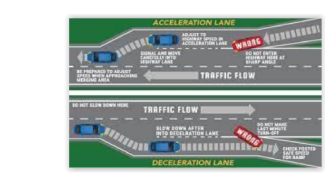Freeway/Highway Driving Limited Access Highway
Highways have controlled areas, and traffic lights, and tend to be placed in rural areas and always allow you to drive off.
Freeways have higher speed limits and are a faster way to get from one city to the other with minimal traffic control.
Limited Access Highways are roads that have been built to allow traffic to move more freely. These roads include interstates and freeways that connect major cities, as well as state highways that connect smaller towns and cities. The term “limited access” means that there are no intersections on these roads.
Driving on freeways can be easier than on other types of roads (no crossroads, traffic lights, or pedestrians) provided the motorist takes necessary precautions and remains alert. Because of the higher speeds of freeway traffic, you may be called upon to think faster, to anticipate situations, and to act sooner.
Sudden lane changes on a freeway by you or another driver can be dangerous. You should use the proper signal for every lane change. When you want to pass, check for fast approaching vehicles to the rear and use your turn signals briefly before beginning your lane change.
If you must stop on a freeway because of mechanical or other emergencies, signal and move your vehicle into the breakdown lane if possible. Beware of vehicles that might be traveling wrongfully in the breakdown lane. Beware of the condition called velocitizing. This happens when you begin to feel that you are going slower than your actual speed. Be particularly aware of velocitizing when preparing to leave a freeway. You must reduce speed and return to normal driving conditions as you approach the exit.
On long freeway trips, pull off the road to a safe place occasionally to rest in a designated safe area (not in the breakdown lane). To avoid the effects of highway hypnosis, (a condition caused by long periods of driving) get out of your vehicle for a while to relax and to take refreshments.
It is recommended motorist on long trips should stop and rest every 100 miles driven or every 2 hours
If it becomes necessary to make repairs along any highway, be sure to move the vehicle to a place where all four wheels are off the main pavement. Be sure to turn on the vehicle’s hazard (emergency) flashing lights. If available, consider using flares, reflectors, or triangles.
Acceleration lanes permit motorists entering freeways the opportunity to accelerate to the speed of traffic.
Deceleration lanes permit motorists about to exit a freeway to slow down to the exit ramp speed.
Merging area is the area beyond the acceleration lane on a freeway where motorists merge into the flow of traffic.
Freeway speeds vary from lane to lane; therefore, it is important for motorists to pick the proper lane to travel. The far-left lane is for passing other vehicles. Trucks, buses, and other special vehicles are prohibited from traveling in this lane where posted. The middle lane(s) is (are) for through traffic. The right lane is for slower moving traffic and for motorists entering and exiting the freeway.
